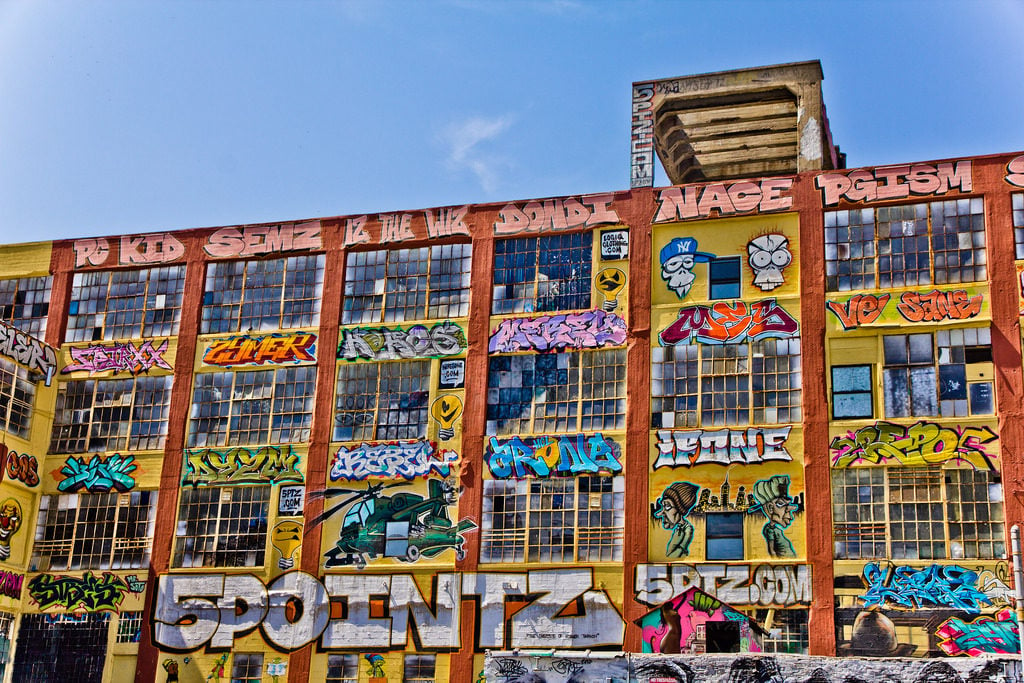Law & Politics
Who Owns Graffiti, the Artists or the Developers? A Landmark Trial Over 5Pointz Considers This With Fresh Eyes
The case, now underway in Brooklyn, could have major implications for artists.

The case, now underway in Brooklyn, could have major implications for artists.

Eileen Kinsella

Does graffiti qualify as important fine art? And if so, does a property owner have a responsibility to preserve it?
These questions are at the heart of a potentially groundbreaking lawsuit underway in Brooklyn, where 20 artists are facing off against a real estate developer over the fate of 5Pointz, the street art mecca in Long Island City, Queens.
More than a dozen artists packed into a federal courtroom on Wednesday to watch as lawyers debated whether the destruction of their murals was a violation of their rights. The case is expected to consider novel questions, including art’s role in gentrification and the growing stature of street art.
“Street art has soared through the roof in terms of popularity and value,” says attorney Barry Werbin of the firm Herrick & Feinstein. “These are all untested issues, which is why the case is so fascinating.” (The judge seems to agree. At the close of arguments on Wednesday, he told the jury they were “lucky” to be involved in such an unusual case.)
At its core, the lawsuit pits artists’ ability to protect and preserve their own work against developers’ authority to do what they please with their own property. The collision course began in 1993, when developer Jerry Wolkoff gave artists free reign over his then-blighted property in Long Island City.
The notion that a developer would partner with graffiti artists—rather than seeking to swat them away—was unheard of at the time. Before long, 5Pointz became a riotously decorated icon of street art. But when Wolkoff decided to demolish the building to make way for condominiums in 2013, he whitewashed the murals in the middle of the night. (He told the New York Times that he took the dramatic measure because it would have been “torture” for the artists to watch their work be slowly dismantled over many months.)
Outraged artists weren’t buying it. They sued later that year, asserting that their work is protected under copyright provisions of the Visual Artists Rights Act of 1990 (also known as VARA). The rarely litigated provision grants artists the right to protect their work from distortion, mutilation, or modification and the right, under some circumstances, to prevent the destruction of a work that is incorporated into a building.
It is extremely rare for VARA cases to make it to court—most are settled or dismissed long before they get there. The 5Pointz trial also marks the first time that a VARA case will be decided by a jury rather than an individual judge with expertise in copyright issues.
“I’m interested in the outcome of whose property rights the court will find to be paramount,” says attorney and intellectual property expert Sergio Muñoz-Sarmiento. “Is it the property owners or is it the artists?” (Muñoz-Sarmiento notes that the verdict will apply only in New York, unless the losing party appeals.)
Barry Werbin suggests that the case will hinge in part on whether the plaintiffs—a group of 20 artists led by longtime 5Pointz curator Jonathan Cohen—can prove that their work is of “recognized stature.” (If the work meets that standard, they would be entitled to damages under VARA.) The problem: “There is very little guidance on what ‘recognized stature’ is,” Werbin notes. “It’s not defined.”
For the time being, the plaintiffs’ efforts at trial have heavily focused on establishing the importance of their work. With a steady stream of artists taking the witness stand, attorney Eric Baum is homing in on the time and effort the artists put into their murals, the impact 5Pointz had on the artists’ reputations, and the damage they suffered as a result of the whitewashing.
In a moment that illustrated the striking contrast between street culture and the formality of the courtroom, Baum asked artist Carlo “Diego” Nieva to read aloud Instagram comments about his now-defunct 5Pointz mural, presumably to demonstrate its positive effect on his career. “That shit is fresh,” Nieva read. “Supah dupah dope,” he went on.
Meanwhile, defense attorney David Ebert sought to challenge the notion that the destruction of 5Pointz had a negative impact on the artists’ bottom lines. He asked them to provide comparable sales and questioned whether a 5Pointz-embedded work could have actually been extracted and sold. He also pointed out that 5Pointz artists routinely painted over one another’s work at the site.
(Baum did not immediately respond to artnet News’s request for comment; Ebert declined to comment while the case is underway.)
Another key facet of the case—which the artists do not dispute—is that Wolkoff always made it clear that 5Pointz would not be permanent. The artists “did this work with eyes wide open…. They knew there was no permanency here,” Werbin notes.
Following the testimony of the roughly two dozen artists who are plaintiffs in the case, attorneys will turn their attention to art experts and historians in an attempt to determine whether the 5Pointz murals have “recognized stature.”
In the end, the seven-person jury cannot bring 5Pointz back—but they will decide whether the artists should be paid in exchange for having their work painted over.
“We’re always talking about academics, art historians, and legal scholars but now we get to see how the people who this art actually impacts views this art and VARA,” Muñoz-Sarmiento says. “Is art or this type of culture really valued to the extent that we, art and legal people, think it is?”